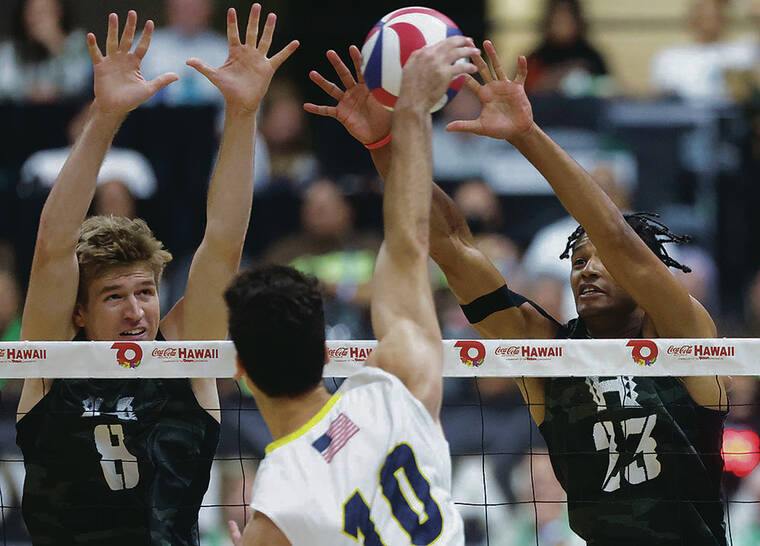Curtis Murayama: Hawaii’s pioneers built girls wrestling
What’s the most important book in high school? It’s not your math book or English book or science book.
It’s your yearbook.
It carries intense interest the day you get it, maintains its level of curiosity whenever a reunion approaches and provides a source of reflection years later.
So after seeing my daughter peruse her yearbook, I decided to look at mine. Yeah, I know, it was 50 years ago from a school I call ‘Iolani mauka (that’s Kaimuki High, people). Regardless, it’s still a historical publication.
The most interesting and eye-opening things I noticed — besides my being thinner with more hair — a lack of girls’ sports.
No basketball, no softball, no wrestling.
Don't miss out on what's happening!
Stay in touch with breaking news, as it happens, conveniently in your email inbox. It's FREE!
They didn’t exist back then. Now, it’s hard to imagine sports without them.
The first girls state basketball and softball tournaments were held in 1977, 18 years after the first boys tournaments.
Girls wrestling? Non-existent until 32 years after the boys’ first state tournament in 1966.
Before that, any girl who wanted to wrestle would have to wrestle a boy.
The state set out to change that by initiating a pilot program in the 1997-98 season, with the first girls tournament being held in 1998.
But while it might not have been soon enough for some, at least Hawaii was the first in the nation.
“I like to brag to everyone on the mainland that Hawaii was the first state to sanction girls wrestling,” said Clarissa Chun, a two-time state champion at Roosevelt who became Hawaii’s only Olympic medalist (bronze, 2012 London Olympics) and is now an assistant coach with the USA women’s wrestling team.
Added Joan Fulp, the USAW Girls High School Development Committee Co-Chair and USA Wrestling Board of Directors 2nd Vice President, in an email to the Star-Advertiser: “Hawaii’s place as the first state to separate boys and girls competition will forever stand as the example to emulate. Thank you Hawaii, for leading the way!!!”
The administrators responsible for paving the way were since-retired athletic directors Carl Schroers of ‘Iolani and George Goto of Moanalua.
“We brought it up, discussed it (at the athletic directors’ conference) and it was voted in. Gender equity was a big thing in the 1990s,” said Goto, 76.
“We seemed to have had a lot of interest in a girls program, especially in the OIA, and as soon as we started introducing a girls program, then we had a lot of participation now that they knew we had a program. (We) had parents complaining. They wanted their own (tournament). They didn’t want girls wrestling guys.”
Said Schroers, 70, who also coached wrestling at ‘Iolani for more than 20 years: “You can’t say we can’t do this because they’re girls. Wrestling is for anybody.”
Not every state, however, believes that.
While Texas sanctioned wrestling a year after Hawaii, other states were slow to follow.
“It’s wild to think it’s taken this long for there to be a little more momentum for girls wrestling to be sanctioned as a high school sport,” Chun said. “I think we’re at 33 states now that has sanctioned it as a sport. Up until a few years ago, there were under 10 states.”
What might have aided in the introduction of girls wrestling in Hawaii was the popularity of another local mat sport— judo.
“It was easier for us because Hawaii already had judo (clubs),” said Joel Kawachi, Moanalua’s athletic director who was the first coach to win three girls state titles in a row (1999-2001). “We could just adopt the 10 weight classes from judo. Administratively, it made it easier for our state.”
In fact, Chun was a judoka before a grappler.
“I grew up doing judo. So I had teammates, in my judo club, that were older, I have an older brother, we all grew up doing judo.”
Chun remembers first seeing girls wrestle when she was in middle school.
“We had some friends in our judo club that wrestled. I remember going to watch and there would be a couple girls in the mid-’90s. They would wear a white t-shirt under their singlet. And that was the first time I saw girls wrestle, but they’d wrestle boys.” (“They didn’t make singlets for girls (back then),” Kawachi said.)
That didn’t change for Chun in her high school career. She said she wrestled boys during dual meets and girls during tournaments.
Although there were just two female wrestlers on the Rough Riders, Chun said overall, “there was a pretty good turnout with the amount of girls that came out in the first pilot year.”
After an immediate growth spurt, participation in girls wrestling has leveled off, though its intensity remains high.
In 2020, Nanea Estrella became the sixth girl in Hawaii to win four state titles, a number that matches the boys.
“I feel pretty good about it,” Goto said about Hawaii being one of forerunners to sanction girls wrestling. “When I look at other states it seems we’re so far ahead and it’s been over 20 years.”
Chun actually has proof that girls were trying to wrestle more than a half-century ago.
“Researchers came across this article, (it) was the state of Indiana prohibiting women from wrestling in 1955. So women have been trying to wrestling since 1955. To me, that was like, what? Wow? I thought that (interest in girls wrestling) was more a newer thing, like ’70s at the earliest, but ’55? Ironic thing, we have six female Olympians on the wrestling team this year, two out of the six are from the state of Indiana.”





